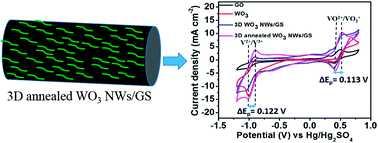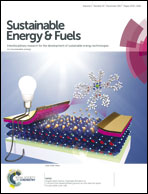Three-dimensional annealed WO3 nanowire/graphene foam as an electrocatalytic material for all vanadium redox flow batteries†
Abstract
This paper presents a three-dimensional annealed tungsten trioxide nanowire/graphene sheet (3D annealed WO3 NWs/GS) foam as an excellent and low-cost electrocatalyst. It was prepared using vanadium redox flow battery (VRFB) electrodes through an in situ self-assembly of graphene sheets prepared by mild chemical reduction, followed by freeze-drying and annealing. The 3D annealed WO3 NWs/GS foam exhibits the highest electrocatalytic activities toward V2+/V3+ and VO2+/VO2+ redox couples among all the tested samples. Charge–discharge tests further confirm that a single flow cell of a VRFB using the 3D annealed WO3 NWs/GS foam demonstrates excellent energy efficiencies of 79.49% and 83.73% at current densities of 80 mA cm−2 and 40 mA cm−2, respectively, which are much higher than those of cells assembled with pristine graphite felt (GF) and 3D WO3 NWs/GS foam without annealing treatment. Moreover, it shows no obvious degradation after 50 charge–discharge cycles. These results are attributed to the formation of new W–O–C bonds, confirming that the WO3 NWs are anchored strongly to the GS, which is key to facilitating the redox reactions of the vanadium redox couples. Moreover, the 3D annealed WO3 NWs/GS foam exhibits a 3D hierarchical porous structure, which can provide more surface electroactive sites to improve the electrochemical performance of VRFBs.



 Please wait while we load your content...
Please wait while we load your content...